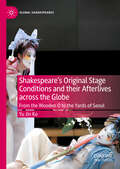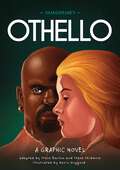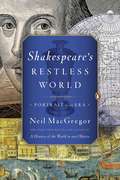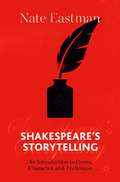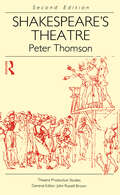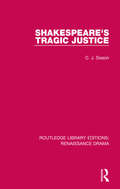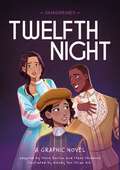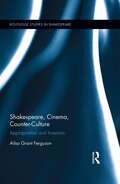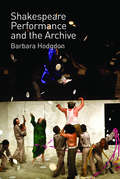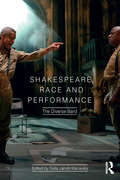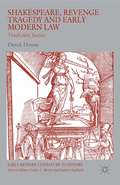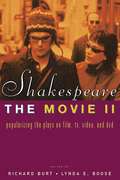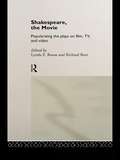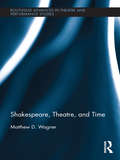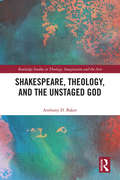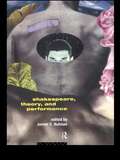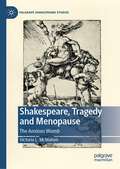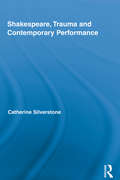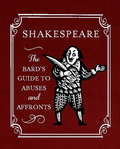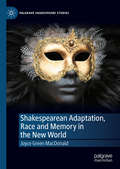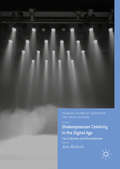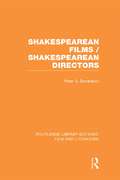- Table View
- List View
Shakespeare's Original Stage Conditions and their Afterlives across the Globe: From the Wooden O to the Yards of Seoul (Global Shakespeares)
by Yu Jin KoThis book brings together two separate fields by combining a study of Shakespeare's original stage conditions with an exploration of his plays in performance across the globe. The book contributes new insights into how early-modern stage conditions shaped the writing, production, and reception of Shakespeare's plays, but takes the further step of examining how original stage conditions re-emerge, not only in Globe replicas like the London Globe, but in unexpected and sometimes unconscious reconfigurations in adaptations and productions from around the world: film versions of Othello from Mexico to India that take dancing cues and anxieties about dance from the play and centralize dance; Korean adaptations for the madang (or yard) that reimagine Shakespeare's theatrical spaces and their relationships to audiences; Noh re-imaginings on film and onstage that foreground the theatrical; a teen film remake of Othello that raises questions about how blackness is figured today and on Shakespeare's stage, among others. By studying original stage conditions and their global afterlives, the book illuminates how global productions negotiate historical and cultural differences and thereby, paradoxically, engage with the cultural specificities of the present.
Shakespeare's Othello: A Graphic Novel (Classics in Graphics #8)
by Steve Skidmore Steve BarlowShakespeare's Othello like you've never seen it - or read it - before! Classics in Graphics: Othello has been adapted into a graphic novel by expert authors, Steve Skidmore and Steve Barlow, with illustrations by Kevin Hopgood and Martyn Cain. Watch Iago's slimy plan play out like an irresistible thriller - as Othello's self-doubt turns to fury and becomes more and more consuming.Classics in Graphics is a series of graphic novels for readers aged 10 plus that has inclusion at its heart, flinging wide the doors of literature for all to enter and understand. Including dyslexia-friendly design and encouraging readers to relate to iconic roles - casting spells, falling in love and winning duels. Each graphic novel includes pitch-perfect illustrations for depicting tragedy, romance, comedy or magic PLUS: - snappy simplified text presenting Shakespeare's themes clearly - introductory materials to help set the scene and context of each story - heaps of extra material at the back to keep the learning and fun going, including an exploration of themes in the play, the language, Shakespeare's inspirations, the publication and performance of the play in history, a timeline of Shakespeare's life and works, and much more! Plays available in the series include: Macbeth, The Tempest, Hamlet, Romeo and Juliet, A Midsummer Night's Dream, Much Ado About Nothing, Othello, Twelfth NightPraise for Classics in Graphics: "[...] an encouraging entry point to Shakespeare for my kids, and [...] an excellent job converting challenging language and literary themes to make it very inclusive, smoothing ease of understanding dialogue, plot, and narration without dumbing it down." - EricWilliamson, leagueofcomicgeeks.com
Shakespeare's Possible Worlds
by Simon PalfreyNew methods are needed to do justice to Shakespeare. His work exceeds conventional models, past and present, for understanding playworlds. In this book, Simon Palfrey goes right to the heart of early modern popular drama, revealing both how it works and why it matters. Unlike his contemporaries, Shakespeare gives independent life to all his instruments, and to every fraction and fragment of the plays. Palfrey terms these particles 'formactions' - theatre-specific forms that move with their own action and passion. Palfrey's book is critically daring in both substance and format. Its unique mix of imaginative gusto, thought experiments, and virtuosic technique generates piercing close readings of the plays. There is far more to playlife than meets the eye. Influenced by Leibniz's visionary original model of possible worlds, Palfrey opens up the multiple worlds of Shakespeare's language, scenes, and characters as never before.
Shakespeare's Restless World
by Neil MacgregorWilliam Shakespeare lived through a pivotal period in human history. With the discovery of the New World, the horizons of Old Europe were expanding dramatically, long-cherished certainties were crumbling and life was exhilaratingly uncertain. What ideas and assumptions did Londoners bring with them when they went to see Shakespeare's plays in the 1590s and 1600s - what were they thinking? What was it like living in a world so radically different from anything their parents had experienced?Shakespeare's Restless World uncovers the fascinating stories behind 20 objects from Shakespeare's life and times to recreate his world and the minds of his audiences. The objects range from the rich (such as the hoard of gold coins that make up the Salcombe treasure) to the very humble, like the battered trunk and worn garments of an unknown pedlar. Each of them allows MacGregor to explore one of the defining themes of the Shakespearean age - globalisation, reformation, piracy, Islam, magic and many others. MacGregor weaves Shakespeare's words themselves into the histories of his objects to suggest where his ideas about religion, national identity, the history of England and the world, human nature itself, may have come from. The result is an excitingly fresh and unexpected portrait of Shakespeare's dangerous and dynamic world.
Shakespeare's Storytelling: An Introduction to Genre, Character, and Technique
by Nate EastmanShakespeare’s Storytelling: An Introduction to Genre, Character, and Technique is a textbook focused on specific storytelling techniques and genres that Shakespeare invented or refined. Drawing on examples from popular novels, plays, and films (such as IT, Beloved, Sex and the City, The Godfather, and Fences) the book provides an overview of how Shakespearean storytelling techniques including character flaws, conflicts, symbols, and more have been adapted by later writers and used in the modern canon. Rather than taking a historicist or theoretical approach, Nate Eastman uses recognizable references and engaging language to teach the concepts and techniques most applicable to the future study of Creative Writing, English, Theater, and Film and Media. Students will be prepared to interpret Shakespeare’s plays and understand Shakespeare as the beginning of a literary tradition. A readable introduction to Shakespeare and his significance, this book is suitable for undergraduates.
Shakespeare's Theatre (Theatre Production Studies)
by Peter ThomsonReviews of the First Edition `...valuable and enjoyable reading for all studying Shakespeare's plays.' Following in the patternestablished by John Russell Brown for the excellent series (Theatre and Production Studies), he provides first an account of Shakespeare's company, then a study of three individual plays Twelfth Night, Hamlet and Macbeth as performed by the company. Peter Thomson writes in a crisp, sharp, enlivening style.' TLS '`...the best analysis yet of Elizabethan acting practices, excavated form the texts themselves rather than reconstructed on basis of one monolithic theory, and an essay on Hamlet that is a model of Critical intelligence and theatrical invention.' Yearbook of English Studies `Synthesizes the important facts and summarizes projects with a vigorous prose style, and expertly applies his experience in both practical drama and academic teaching to his discussion.' Review of English Studies
Shakespeare's Tragic Justice (Routledge Library Editions: Renaissance Drama)
by C. J. SissonThe problem of justice seems to have haunted Shakespeare as it haunted Renaissance Christendom. In this book, first published in 1963, four aspects of the problems of justice in action in Shakespeare’s great tragedies are explored. This study is based on the lifetime’s research of Elizabethan habits of mind by one of the most distinguished Shakespearean scholars, and will be of interest to students of English Literature, Drama and Performance.
Shakespeare's Twelfth Night: A Graphic Novel (Classics in Graphics #7)
by Steve Skidmore Steve BarlowShakespeare's Twelfth Night like you've never seen it - or read it - before! Classics in Graphics: Twelfth Night has been adapted into a graphic novel by expert authors, Steve Skidmore and Steve Barlow, with illustrations by Wendy Tan Shiau Wei. Experience the famous (and famously confusing) love triangle, presented with all the flair of your favourite rom-com.Classics in Graphics is a series of graphic novels for readers aged 10 plus that has inclusion at its heart, flinging wide the doors of literature for all to enter and understand. Including dyslexia-friendly design and encouraging readers to relate to iconic roles - casting spells, falling in love and winning duels. Each graphic novel includes pitch-perfect illustrations for depicting tragedy, romance, comedy or magic PLUS: - snappy simplified text presenting Shakespeare's themes clearly - introductory materials to help set the scene and context of each story - heaps of extra material at the back to keep the learning and fun going, including an exploration of themes in the play, the language, Shakespeare's inspirations, the publication and performance of the play in history, a timeline of Shakespeare's life and works, and much more! Plays available in the series include: Macbeth, The Tempest, Hamlet, Romeo and Juliet, A Midsummer Night's Dream, Much Ado About Nothing, Othello, Twelfth NightPraise for Classics in Graphics: "[...] an encouraging entry point to Shakespeare for my kids, and [...] an excellent job converting challenging language and literary themes to make it very inclusive, smoothing ease of understanding dialogue, plot, and narration without dumbing it down." - EricWilliamson, leagueofcomicgeeks.com
Shakespeare, Brecht, and the Intercultural Sign
by Antony TatlowIn Shakespeare, Brecht, and the Intercultural Sign renowned Brecht scholar Antony Tatlow uses drama to investigate cultural crossings and to show how intercultural readings or performances question the settled assumptions we bring to interpretations of familiar texts. Through a "textual anthropology" Tatlow examines the interplay between interpretations of Shakespeare and readings of Brecht, whose work he rereads in the light of theories of the social subject from Nietzsche to Derrida and in relation to East Asian culture, as well as practices within Chinese and Japanese theater that shape their versions of Shakespearean drama. Reflecting on how, why, and to what effect knowledges and styles of performance pollinate across cultures, Tatlow demonstrates that the employment of one culture's material in the context of another defamiliarizes the conventions of representation in an act that facilitates access to what previously had been culturally repressed. By reading the intercultural, Tatlow shows, we are able not only to historicize the effects of those repressions that create a social unconscious but also gain access to what might otherwise have remained invisible. This remarkable study will interest students of cultural interaction and aesthetics, as well as readers interested in theater, Shakespeare, Brecht, China, and Japan.
Shakespeare, Cinema, Counter-Culture: Appropriation and Inversion (Routledge Studies in Shakespeare #17)
by Ailsa Grant FergusonAddressing for the first time Shakespeare’s place in counter-cultural cinema, this book examines and theorizes counter-hegemonic, postmodern, and post-punk Shakespeare in late 20th and early 21st century film. Drawing on a diverse range of case studies, Grant Ferguson presents an interdisciplinary approach that offers new theories on the nature and application of Shakespearean appropriations in the light of postmodern modes of representation. The book considers the nature of the Shakespearean inter-text in subcultural political contexts concerning the politicized aesthetics of a Shakespearean ‘body in pieces,’ the carnivalesque, and notions of Shakespeare as counter-hegemonic weapon or source of empowerment. Representative films use Shakespeare (and his accompanying cultural capital) to challenge notions of capitalist globalization, dominant socio-cultural ideologies, and hegemonic modes of expression. In response to a post-modern culture saturated with logos and semiotic abbreviations, many such films play with the emblematic imagery and references of Shakespeare’s texts. These curious appropriations have much to reveal about the elusive nature of intertextuality in late postmodern culture and the battle for cultural ownership of Shakespeare. As there has yet to be a study that isolates and theorizes modes of Shakespearean production that specifically demonstrate resistance to the social, political, ideological, aesthetic, and cinematic norms of the Western world, this book expands the dialogue around such texts and interprets their patterns of appropriation, adaptation, and representation of Shakespeare.
Shakespeare, Performance and the Archive
by Barbara HodgdonShakespeare, Performance and the Archive is a ground-breaking and movingly written exploration of what remains when actors evacuate the space and time of performance. An analysis of ‘leftovers’, it moves between tracking the politics of what is consciously archived and the politics of visible and invisible theatrical labour to trace the persistence of performance. In this fascinating volume, Hodgdon considers how documents, material objects, sketches, drawings and photographs explore scenarios of action and behaviour – and embodied practices. Rather than viewing these leftovers as indexical signs of a theatrical past, Hodgdon argues that the work they do is neither strictly archival nor documentary but performative – that is, they serve as sites of re-performance. Shakespeare, Performance and the Archive creates a deeply materialized historiography of performance and attempts to make that history do something entirely new. Barbara Hodgdon is Professor of English at the University of Michigan, now retired. Her major interest is in theatrical performances, especially performed Shakespeare. She is the author of: The End Crowns All, The Shakespeare Trade, and most recently the Arden edition of The Taming of the Shrew.
Shakespeare, Race and Performance: The Diverse Bard
by Delia Jarrett-MacauleyWhat does it mean to study Shakespeare within a multicultural society? And who has the power to transform Shakespeare? The Diverse Bard explores how Shakespeare has been adapted by artists born on the margins of the Empire, and how actors of Asian and African-Caribbean origin are being cast by white mainstream directors. It examines how notions of 'race' define the contemporary British experience, including the demands of traditional theatre, and it looks at both the playtexts themselves and contemporary productions. Editor Delia Jarrett-Macauley assembles a stunning collection of classic texts and new scholarship by leading critics and practitioners, to provide the first comprehensive critical and practical analysis of this field.
Shakespeare, Revenge Tragedy and Early Modern Law: Vindictive Justice (Early Modern Literature in History)
by Derek DunneThis book, the first to trace revenge tragedy's evolving dialogue with early modern law, draws on changing laws of evidence, food riots, piracy, and debates over royal prerogative. By taking the genre's legal potential seriously, it opens up the radical critique embedded in the revenge tragedies of Kyd, Shakespeare, Marston, Chettle and Middleton.
Shakespeare, The Movie II: Popularizing the Plays on Film, TV, Video and DVD
by Richard Burt Lynda E. BooseFollowing on from the phenomenally successful Shakespeare, The Movie, this volume brings together an invaluable new collection of essays on cinematic Shakespeares in the 1990s and beyond. Shakespeare, The Movie II:*focuses for the first time on the impact of postcolonialism, globalization and digital film on recent adaptations of Shakespeare;*takes in not only American and British films but also adaptations of Shakespeare in Europe and in the Asian diapora;*explores a wide range of film, television, video and DVD adaptations from Almereyda's Hamlet to animated tales, via Baz Luhrmann, Kenneth Branagh, and 1990s' Macbeths, to name but a few;*offers fresh insight into the issues surrounding Shakespeare on film, such as the interplay between originals and adaptations, the appropriations of popular culture, the question of spectatorship, and the impact of popularization on the canonical status of "the Bard."Combining three key essays from the earlier collection with exciting new work from leading contributors, Shakespeare, The Movie II offers sixteen fascinating essays. It is quite simply a must-read for any student of Shakespeare, film, media or cultural studies.
Shakespeare, The Movie: Popularizing the Plays on Film, TV and Video
by Richard Burt Lynda E. BooseShakespeare, The Movie brings together an impressive line-up of contributors to consider how Shakespeare has been adapted on film, TV, and video, and explores the impact of this popularization on the canonical status of Shakespeare.Taking a fresh look at the Bard an his place in the movies, Shakespeare, The Movie includes a selection of what is presently available in filmic format to the Shakespeare student or scholar, ranging across BBC television productions, filmed theatre productions, and full screen adaptations by Kenneth Branagh and Franco Zeffirelli. Films discussed include:* Amy Heckerling's Clueless* Gus van Sant's My Own Private Idaho* Branagh's Henry V* Baz Luhrman's William Shakespeare's Romeo and Juliet* John McTiernan's Last Action Hero* Peter Greenaway's Prospero's Books* Zeffirelli's Hamlet.
Shakespeare, Theatre, and Time (Routledge Advances in Theatre & Performance Studies #20)
by Matthew WagnerThat Shakespeare thematized time thoroughly, almost obsessively, in his plays is well established: time is, among other things, a 'devourer' (Love's Labour's Lost), one who can untie knots (Twelfth Night), or, perhaps most famously, simply ‘out of joint’ (Hamlet). Yet most critical commentary on time and Shakespeare tends to incorporate little focus on time as an essential - if elusive - element of stage praxis. This book aims to fill that gap; Wagner's focus is specifically performative, asking after time as a stage phenomenon rather than a literary theme or poetic metaphor. His primary approach is phenomenological, as the book aims to describe how time operates on Shakespearean stages. Through philosophical, historiographical, dramaturgical, and performative perspectives, Wagner examines the ways in which theatrical activity generates a manifest presence of time, and he demonstrates Shakespeare’s acute awareness and manipulation of this phenomenon. Underpinning these investigations is the argument that theatrical time, and especially Shakespearean time, is rooted in temporal conflict and ‘thickness’ (the heightened sense of the present moment bearing the weight of both the past and the future). Throughout the book, Wagner traces the ways in which time transcends thematic and metaphorical functions, and forms an essential part of Shakespearean stage praxis.
Shakespeare, Theology, and the Unstaged God (Routledge Studies in Theology, Imagination and the Arts)
by Anthony D. BakerWhile many scholars in Shakespeare and Religious Studies assume a secularist viewpoint in their interpretation of Shakespeare’s works, there are others that allow for a theologically coherent reading. Located within the turn to religion in Shakespeare studies, this book goes beyond the claim that Shakespeare simply made artistic use of religious material in his drama. It argues that his plays inhabit a complex and rich theological atmosphere, individually, by genre and as a body of work. The book begins by acknowledging that a plot-controlling God figure, or even a consistent theological dogma, is largely absent in the plays of Shakespeare. However, it argues that this absence is not necessarily a sign of secularization, but functions in a theologically generative manner. It goes on to suggest that the plays reveal a consistent, if variant, attention to the theological possibility of a divine "presence" mediated through human wit, both in gracious and malicious forms. Without any prejudice for divine intervention, the plots actually gesture on many turns toward a hidden supernatural "actor", or God. Making bold claims about the artistic and theological of Shakespeare’s work, this book will be of interest to scholars of Theology and the Arts, Shakespeare and Literature more generally.
Shakespeare, Theory and Performance
by James C. BulmanShakespeare, Theory and Performance is a groundbreaking collection of seminal essays which apply the abstract theory of Shakespearean criticism to the practicalities of performance. Bringing together the key names from both realms, the collection reflects a wide range of sources and influences, from traditional literary, performance and historical criticism to modern cultural theory. Together they raise questions about the place of performance criticism in modern and often competing debates of cultural materialism, new historicism, feminism and deconstruction. An exciting and fascinating volume, it will be important reading for students and scholars of literary and theatre studies alike.
Shakespeare, Tragedy and Menopause: The Anxious Womb (Palgrave Shakespeare Studies)
by Victoria L. McMahonShakespeare was not only aware of the socio-cultural fears and anxieties generated by the older woman’s body but with the characterization of his tragic ageing females, Shakespeare becomes the first literary giant to explore the physiological and psychosocial condition that we have come to know as ‘menopause’. Although ‘menopause’ was not defined as a medical, physiological or sociocultural event for the early moderns, this book argues that such a medical and cultural transition can, in fact, be identified by sub-textual clues distinguished by various embodied anxieties. It explores several ageing women of the Shakespearean tragedies as they transition through this liminal menopausal period. Theoretically underscored by humoral theory, the analysis is metonymically centered upon the womb as the seat of menopausal anxiety. These menopausal undercurrents, not only permeate the dramatic action of each play, but also emanate outward to reflect the medical, physiological, cultural, social, and religious concerns generated by the ageing woman of the early modern period at large.
Shakespeare, Trauma and Contemporary Performance (Routledge Studies in Shakespeare)
by Catherine SilverstoneShakespeare, Trauma and Contemporary Performance examines how contemporary performances of Shakespeare’s texts on stage and screen engage with violent events and histories. The book attempts to account for – but not to rationalize – the ongoing and pernicious effects of various forms of violence as they have emerged in selected contemporary performances of Shakespeare’s texts, especially as that violence relates to apartheid, colonization, racism, homophobia and war. Through a series of wide-ranging case studies, which are informed by debates in Shakespeare, trauma and performance studies and developed from extensive archival research, the book examines how performances and their documentary traces work variously to memorialize, remember and witness violent events and histories. In the process, Silverstone considers the ethical and political implications of attempts to represent trauma in performance, especially in relation to performing, spectatorship and community formation. Ranging from the mainstream to the fringe, key performances discussed include Gregory Doran’s Titus Andronicus (1995) for Johannesburg’s Market Theatre; Don C. Selwyn’s New Zealand-made film, The Maori Merchant of Venice (2001); Philip Osment’s appropriation of The Tempest in This Island’s Mine for London’s Gay Sweatshop (1988); and Nicholas Hytner’s Henry V (2003) for the National Theatre in London.
Shakespeare, the Queen'S Men, and the Elizabethan Performance of History
by Brian WalshThe Elizabethan history play was one of the most prevalent dramatic genres of the 1590s, and so was a major contribution to Elizabethan historical culture. The genre has been well served by critical studies that emphasize politics and ideology; however, there has been less interest in the way history is interrogated as an idea in these plays. Drawing in period-sensitive ways on the field of contemporary performance theory, Walsh looks at the Shakespearean history play from a fresh angle, by first analyzing the foundational work of the Queen's Men, the playing company that invented the popular history play. Through innovative readings of their plays including The Famous Victories of Henry V before moving on to Shakespeare's 1 Henry VI, Richard III, and Henry V, this book investigates how the Queen's Men's self-consciousness about performance helped to shape Shakespeare's dramatic and historical imagination.
Shakespeare: The Bard's Guide to Abuses and Affronts (RP Minis)
by Edited by Nancy ArmstrongPresenting a most civilized way to silence boors, deflect rudeness, and chide churlish lovers: Our mini book of insults culled from the dramatic works of English literature's most gifted wordsmith. Shakespeare's enduring putdowns include "Thou art a very ragged Wart" (Henry IV), "Thy kiss is as comfortless as frozen water to a starved snake" (Troilus and Cressida), and "In civility thou seem'st so empty" (As You Like It). Why resort to vulgarity when a high-brow literary epithet does the job so well?
Shakespearean Adaptation, Race and Memory in the New World (Palgrave Shakespeare Studies)
by Joyce Green MacDonaldAs readers head into the second fifty years of the modern critical study of blackness and black characters in Renaissance drama, it has become a critical commonplace to note black female characters’ almost complete absence from Shakespeare’s plays. Despite this physical absence, however, they still play central symbolic roles in articulating definitions of love, beauty, chastity, femininity, and civic and social standing, invoked as the opposite and foil of women who are “fair”. Beginning from this recognition of black women’s simultaneous physical absence and imaginative presence, this book argues that modern Shakespearean adaptation is a primary means for materializing black women’s often elusive presence in the plays, serving as a vital staging place for historical and political inquiry into racial formation in Shakespeare’s world, and our own. Ranging geographically across North America and the Caribbean, and including film and fiction as well as drama as it discusses remade versions of Othello, Romeo and Juliet, Antony and Cleopatra, and The Taming of the Shrew, Shakespearean Adaptation, Race, and Memory in the New World will attract scholars of early modern race studies, gender and performance, and women in Renaissance drama.
Shakespearean Celebrity in the Digital Age: Fan Cultures and Remediation (Palgrave Studies in Adaptation and Visual Culture)
by Anna BlackwellThis book offers a timely examination of the relationship between Shakespeare and contemporary digital media. By focusing upon a variety of ‘Shakespearean’ individuals, groups and communities and their ‘online’ presence, the book explores the role of popular internet culture in the ongoing adaptation of Shakespeare’s plays and his general cultural standing. The description of certain performers as ‘Shakespearean’ is a ubiquitous but often throwaway assessment. However, a study of ‘Shakespearean’ actors within a broader cultural context reveals much, not only about the mutable face of British culture (popular and ‘highbrow’) but also about national identity and commerce. These performers share an online space with the other major focus of the book: the fans and digital content creators whose engagement with the Shakespearean marks them out as more than just audiences and consumers; they become producers and critics. Ultimately, Digital Shakespeareans moves beyond the theatrical history focus of related works to consider the role of digital culture and technology in shaping Shakespeare’s contemporary adaptive legacy and the means by which we engage with it.
Shakespearean Films/Shakespearean Directors (Routledge Library Editions: Film and Literature)
by Peter S. DonaldsonOriginally published in 1990, this book brought a new rigor and subtlety to the interpretation of film adaptations of Shakespeare. Drawing on traditional literary analysis, psychoanalysis, and current film theory about gender and subjectivity, the author combines close readings of seven films with historical and biographical studies of the directors who made them. Offering substantial readings of Jean-Luc Godard’s controversial deconstructed King Lear and of Liz White’s independent African-American Othello, Donaldson also applies his provocative and contemporary point of view to more familiar films. He reads Olivier’s Henry V in relation to its treatment of sexual difference; Olivier’s Hamlet in part as an expression of the director’s childhood sexual trauma; Kurosawa’s Throne of Blood as an allegory of the relationship between Western and Japanese cinema; and Zeffirelli’s immensely popular Romeo and Juliet in the light of its powerful homoerotic subtext. With striking perspectives on Shakespeare, on the movies as an expressive medium, and on the complex processes of cultural change, this is timeless useful reading for teachers and students of film and literature.
